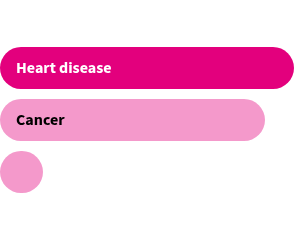What are the top causes of death for people 65 and older?
Between 2020 and 2021, the top cause of death for people 65 and older was heart disease in 47 statesand Washington, DC.
The top two causes of death for senior citizens in 2022 were heart diseases and cancer at 1,015.9 and 810.2 deaths per 100,000 people, respectively, according to provisional data from the Centers for Disease Control and Prevention (CDC).
COVID-19 (262 per 100,000 people), cerebrovascular diseases (255.2 per 100,000), and chronic lower respiratory diseases (255.2 per 100,000) followed as the next most common causes of death for seniors. These were also the leading causes of death in 2021 — the most recent year with final data.
How have the causes of death for seniors changed over time?
Heart disease, cancer, cerebrovascular disease, and chronic lower respiratory diseases were the top four causes of death for seniors (people 65 and older) in 2000. The fifth most common cause was influenza and pneumonia, with 167.3 deaths per 100,000 people.
Influenza and pneumonia were the 12th-most-common cause of death by 2021, with deaths dropping to 60.3 per 100,000. Instead, COVID-19 ranked in the top five.
COVID-19 became a leading cause of death for people 65 and over in 2020. Similarly, death rates due to heart diseases, cancer, and cerebrovascular diseases for older Americans have also increased since 2020.
However, fewer people 65 and over are dying of the top five causes of death now than than in 2000; decreases in crude death rate sources per 100,000 people 65 and over include:
- Heart disease: down 41.6% since 2000
- Cerebrovascular diseases: down 41.1% since 2000
- Chronic lower respiratory disease: down 29.2% since 2000
- Cancers: down 28.7% since 2000
Do the top causes of death for senior citizens vary by state?
Heart disease was the top cause of death for people 65 and older between 2020 and 2021 in 47 states and Washington, DC. In the other three states — Alaska, Minnesota, and Oregon — cancer was the leading cause.
Has the state data changed over time?
Heart disease has been the leading cause of death for senior citizens in almost every state for the past two decades; between 2001 and 2002, it was the leading cause in every state except Alaska. But at the same time, the death rate for heart disease decreased in every state by at least 291 deaths per 100,000 people. While it remains the leading cause of death, fewer seniors diagnosed with heart disease actually die from it.

What's driving the decrease in death rates among the leading causes of death?
The leading causes of death for people over 65 were relatively consistent between 2000–2022, but most rates of death have decreased over time. Improvements in medical care and efforts to reduce the risk factors associated with heart disease may be contributing to the decrease.
The drop in influenza and pneumonia deaths could be due to scientific advancements such as a high-dose flu vaccine designed specifically for people 65 and older, along with among other advancements in public awareness and vaccine efficacy.
Learn more about how America cares for older adults, and get the data directly in your inbox by signing up for our email newsletter.
Keep exploring
Page sources
Centers for Diseases Control and Prevention
Underlying Cause of Death
